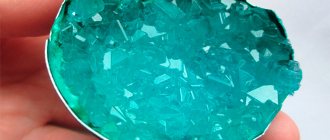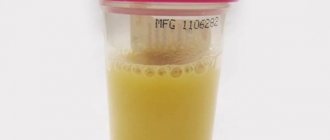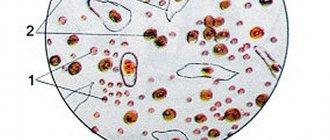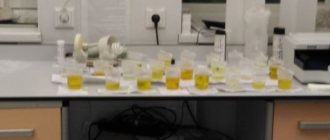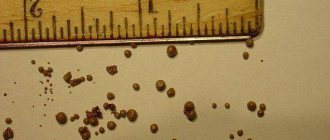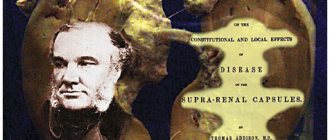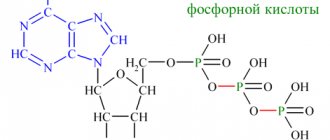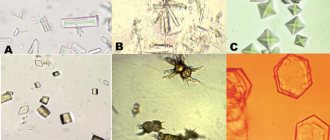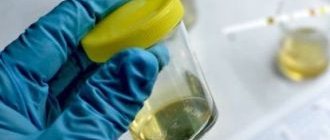Causes of appearance in urine
It should be noted that the risk group for the development of urinary tract inflammation caused by Proteus are patients:
- With reduced immunity (with HIV or other immunodeficiency conditions) and chronic, including autoimmune, diseases (urolithiasis, ulcerative colitis, Crohn's disease, systemic lupus erythematosus, diabetes mellitus), hormonal disorders.
- Anomalies in the structure of the urinary system, functional and neurogenic disorders in this area (reflux, dysfunctional urination)
- Those who have undergone surgical interventions and manipulations (gynecological operations, catheterization of the bladder, ureter, etc.) in a hospital setting
- Pregnant
- Elderly and senile people
Proteus mirabilis Infection
Symptoms
These are some of the most common symptoms that are caused by the infection with Proteus mirabilis:
- Urinary tract infection
- Flank pain
- Hematuria (blood in the urine)
- Dysuria
- Puria
- Increased urination frequency
- Urethral discharge (in men)
- Suprapubic pain
- Urgency to urinate
- Back pain
- The urine has a concentrated appearance
- Systemic symptoms can also be present, being suggestive of a severe bacterial infection and possible sepsis (high-running fever) – more common in patients who have been catheterized for prolonged periods of time
- Fever and chills might be present in men who are suffering from the chronic inflammation of the prostate
- Perianal pain is also a symptom encountered in men diagnosed with the above-mentioned problem
- Nausea and vomiting might be present in patients who suffer from pyelonephritis, caused by the infection with Proteus mirabilis; other symptoms suggestive of this infection include: fever, tenderness in the respective flank and hematuria (blood in the urine)
Causes
These are some of the most common causes that lead to the infection with Proteus mirabilis:
- Recurrent infections (especially UTI)
- Structural abnormalities at the level of the urinary tract
- Urethral instrumentation
- Hospital-acquired infection (especially due to prolonged stay/ reduced immunity)
- Multiple antibiotic treatments
- Urinary tract obstruction
- Urinary catheter (especially when used for prolonged periods of time)
- Neurogenic bladder
- Sexual activity (increased risk for women, especially if no methods of protection were used)
- Other risk factors include – unprotected anal intercourse and uncircumcised penises
- Chronic inflammation of the prostate (recurrent UTIs)
Treatment
Patients who have been infected with Proteus mirabilis can be treated with antibiotics. However, it should be noted that the bacterium has developed resistance to certain antibiotics, such as tetracycline and nitrofurantoin. More recent studies have shown that the bacterium has developed resistance to other antibiotics as well, including to ampicillins and cephalosporin antibiotics (10-20% of the cases). Intravenous antibiotics are administered in the bacterial infections that are severe. Patients who present big kidney stones, causing the obstruction of the urinary tract, will have to undergo surgical intervention. If an abscess has formed because of the infection, surgical removal will be the most recommended approach. In case the infection was so severe that it has caused tissue necrosis, amputation is going to be indicated. In patients who suffer from other pre-existing conditions or those who have a compromised immunity, the mortality rate remains at a high level.
Some patients might present anaphylactic reactions to the administration of antibiotics, so this risk has to be taken into consideration. In case of a severe allergic reaction, adrenaline remains the only course of treatment. Immediate medical intervention is necessary before the symptoms become life-threatening and the patient dies from suffocation. It is also important to note that the antibiotics should be taken for as long as they are prescribed, otherwise the bacteria will develop resistance to the treatment. Apart from that, for the duration of the antibiotic treatment, it is recommended that probiotics are administered as well (so as to protect the healthy intestinal flora).
Clinical symptoms
The symptoms are far from specific for this pathogen and are characterized by local and general signs of an inflammatory reaction:
Local:
- Tubor – swelling.
- Rubor – redness.
- Color – swelling.
- Dolor – pain.
- Functio laesa – dysfunction.
General: chills, increased body temperature, weakness, sweating, dyspeptic symptoms (nausea, vomiting), hemodynamic disorders (as a result of severe intoxication)
Features of symptoms in cases of damage to individual organs:
- Urethritis (pathognomonic is the presence of pathological discharge and pain along the urethra in both men and women).
- Cystitis (frequent excretion of urine in small portions, pain and pain when urinating, terminal hematuria (excretion of a small portion of scarlet blood at the end of urination), pain above the pubis with or without irradiation to neighboring organs, sometimes general signs of inflammation).
- Pyelonephritis (mainly pain syndrome - intense pain in the lumbar region, muscle tension in the anterior abdominal wall and pronounced general signs of inflammation - fever up to 39-41oC, chills, sweating, dyspeptic, hemodynamic disorders)
By infecting the organs of the urinary system, Proteus mirabilis often causes chronic forms of the disease that are difficult to treat!
Bacterial Poisoning Clinic
After the penetration of microbes into the gastrointestinal tract, different time periods pass before the onset of symptoms. The period varies from 2-3 hours to a day. There are exceptions to reduce or increase the period. For example, staphylococcus often makes itself felt half an hour after penetration.
Symptoms of intoxication are uniform in nature and do not depend on the type of pathogen.
Food poisoning of microbial origin is characterized by:
- An increase in body temperature from 38.5 degrees and above;
- The person has a fever;
- Weakness suddenly appears;
- Attacks of headaches occur;
- Muscles, bones, joints begin to ache;
- The epidermis becomes unnaturally pale.
The disease leads to the development of gastroenteritis.
Signs include:
- Repeated eruptions of vomit, with short-term relief occurring during breaks.
- Persistent nausea.
- Profuse diarrhea, the frequency of which reaches 20 times a day. Loose stools may contain mucous accumulations with foam and bloody discharge. The stool also takes on a green tint and emits a specific odor.
- The victim experiences cramping pain in the epigastric region, and there is nagging pain in the umbilical region.
- Change in urine color - from rich to dark shades.
- Blood pressure decreases.
Diagnostics
Diagnosis includes anamnesis (aimed at identifying risk groups) and an objective examination (analysis of the clinical situation).
Laboratory examination includes:
- Determination of the degree of bacteriuria in a single portion of urine . Before collecting the analysis in the morning, a thorough toileting of the genital organs is carried out (improper preparation for the study leads to false positive results). The content of 105 or more microbial bodies of Proteus in 1 ml of fresh urine confirms the presence of an inflammatory process!
- Bacteriological culture of urine for flora and sensitivity to antibiotics . The material is inoculated on nutrient media containing inhibitory substances that suppress the growth of gram-positive flora (bile salts, brilliant green) - Ploskirev’s medium, bismuth-sulfite agar. When sowing on the first week, large, transparent colonies isolated from each other are sown. On bismuth sulfite agar, Proteus grows in the form of dirty brown moist colonies. When carrying out this examination method, it is also possible to determine sensitivity to a certain type of antibacterial drugs.
- Serological reactions - aimed at determining the titer of antibodies in the patient’s blood to a given pathogen - the reliability of the result when the titer increases by at least 3-4 times over time
Instrumental examination methods: ultrasound of the urinary system, radiography, CT, MRI (can be used as additional methods if the results of bacteriological examination are negative, or if difficulties arise in assessing the clinical situation).
Microbes that can cause food poisoning
The difference in the nature of bacteria carries a difference in manifestations. Bacteria and microbes, in their diversity, affect the body in different ways, which is reflected in the symptoms of intoxication.
Pr. mirabilis and Pr. Vulgaris
Causes inflammation. One of the common subspecies is the bacteria B. Proteus. The peculiarity is resistance to heat. Maintains vital potential when exposed to an environment heated to 65 degrees Celsius for a thirty-minute period. It can be kept in dry conditions, that is, in the complete absence of moisture, for up to a year.
The danger of the bacterium lies in its inability to break down protein. If clusters of B. Proteus are present on meat, fish or derivative products, it cannot be detected with the naked eye. Proteas can spread from both raw and cooked food. The product remains unchanged in appearance. Clinical manifestations of Proteus intoxication are characterized by the presence of seizure syndrome and the development of cyanosis on the mucous membranes and epidermis.
Cl. Perfringens
Bacteria-spores that attack meat and fish. They multiply in foods that are kept warm for a long time. Able to survive high temperature processing.
Botulism
The causative agent is the long bacillus of botulinus. It is an anaerobic bacterium that parasitizes in an oxygen-free environment. May contain disputes. The incubation period lasts a day. Appears when storage standards are violated. The phenomenon of botulism is inherent in home canned food due to poor preparation processes.
It can parasitize on meat and fish products, smoked and dried. There is no change in the taste of the food.
The microbe's resistance to high temperatures is minimal. Death occurs in an environment with a temperature of 80 degrees Celsius in fifteen minutes.
However, bacterial spores easily overcome boiling. To completely eliminate botulism, the product must be sterilized.
The danger of botulism lies in its ability to depress the central nervous system. It is absorbed into the blood through the stomach, where it resists oxidation by gastric juice.
The botulism bacterium is extremely dangerous. Intoxication is fatal at a dose of only 0.035 mg.
Staphylococcus
Once in the body, it manifests itself in a period from 2 hours to 2-3 days. Death from staphylococcal intoxication is rare. It exhibits vital activity in products that are distinguished by the possibility of long-term storage:
- Starches: potato, corn, etc.;
- Sugar - refined sugar or sand;
- Raw and cooked fish;
- Pastries with sweet cream;
- Raw or pasteurized milk.
In addition to the listed species, bacterial poisoning can be provoked by other types of pathogens. These include:
- bacilli;
- Citrobacteria;
- Salmonella;
- Shigella;
- Clostridia;
- Escherichia;
- Streptococci.
Without E. coli, normal intestinal functioning is impossible. Enteropathogenic bacteria are part of the intestinal microflora. However, from those listed, it is worth highlighting the salmonella bacterium; in high concentrations it can manifest itself as a toxic infection. Possible infection with salmonellosis is common among poisonings caused by harmful microbes.
Food susceptible to salmonella contamination is of great importance in people's lives and is consumed daily. The most popular types are eggs and meat products. The potential content of salmonella is inherent in jellies, boiled vegetables, food creams in cooking, butter, etc. Insects, for example, flies and rodents, are carriers of the infection. Individuals who have suffered from salmonellosis become exclusive carriers.
Salmonella under a microscope
Antibacterial therapy
Initially, broad-spectrum antibiotics are prescribed as etiotropic therapy! The drugs of choice are: Unidox Solutab, Monural, Norbactin. After receiving the culture results, antibacterial therapy is adjusted accordingly!
Most often, Proteus mirabilis is sensitive to carboxypenicillins (carbenicillin, ticarcillin), ureidopenicillins (azlocillin, piperacillin), 3-4 generation cephalosporins (cefotaxime, ceftriaxone, cefepime), monobactams (aztreonam)
Where is Proteus mirabilis found
Proteus mirabilis is commonly encountered in water and soil. In humans, it is generally found at the level of the intestinal tract, being part of the normal human intestinal flora. The bacterium is also found in hospitals and in clinics that provide treatment on a long-term basis. As it was already mentioned, in hospitals, the bacteria will quickly colonize the skin of patients, and also the oral mucosa. In many cases, the medical staff is also affected by this bacterium. Despite the increased risk for infection, this is not the most encountered nosocomial infections. The most common site of the disease is the genitourinary tract.
Symptomatic therapy
Antipyretic drugs (paracetamol), drugs containing live microcultures (Bifiform, Linex), analgesics, infusion therapy (for symptoms of infectious-toxic shock, hemodynamic disorders)
Doses of drugs and methods of their administration are selected by the attending physician strictly individually according to the morphological parameters of the patient and the severity of his condition!
- Introduction of antiseptic solutions (furatsilin) through the urethra into the bladder
- Physiotherapy (UHF, microwave therapy)
Treatment of Proteus infections
Depending on the patient’s condition, he is prescribed bed rest or semi-bed rest. It is necessary to follow a drinking regime to restore fluid loss, as well as a dietary diet limiting fatty, spicy and salty foods.
Drug therapy:
- Purpose of specific bacteriophages. They are necessary for the rapid growth of Proteus mirabilis. The course of medications and dosage are determined by the attending physician. Before using these products, it is recommended to drink alkaline mineral water.
- Taking probiotics and symbiotics.
- If the growth of Proteus is large, then antibiotics are prescribed. Before their appointment, a special study is carried out to determine the compatibility of bacteria with a certain group of antibacterial drugs. For example, some strains of bacteria are resistant to the tetracycline group. All antibiotics must be prescribed by a doctor.
- Symptomatic therapy.
To avoid encountering this bacterium, it is necessary to take preventive measures. They consist, first of all, in observing hygiene standards and refusing to eat questionable food products. Avoid contact with sick people, especially when it comes to young children.
Proteus vulgaris
are rod-shaped, nitrate-reducing, indole-, hydrogen sulfide- and catalase-positive, gram-negative bacteria that normally populate the gastrointestinal tract of humans and animals (in low titers). Proteus vulgaris
Widely distributed in nature, it can be found in soil, water and feces. Proteus vulgaris
- a representative of the group of enterobacteria and is one of the opportunistic pathogens of humans, animals and birds. Proteus vulgaris
, are known to cause and complicate genitourinary tract infections. Proteus vulgaris
It is also a causative agent of wound infection. According to laboratory tests, Proteus vulgaris
ferments glucose and amygdalin, but does not ferment mannitol or lactose. Proteus vulgaris
also gives a positive result when performing the methyl red test (Voges-Proskauer reaction), and is also an extremely mobile microorganism
For identification of Proteus vulgaris
Positive test results for sulfur utilization, urease, tryptophan, deaminase and indole production are important. It is valuable to identify gelatinase activity and the ability to ferment sucrose, the absence of lysine and ornithine decarboxylase, the inability to ferment adonite, arabinose, sorbitol, dulcite and lactose
The optimal conditions for the growth of this microorganism in a facultative anaerobic environment is an average temperature of about 40° C. Proteus vulgaris
is the causative agent of Proteus nosocomial (nosocomial) infection. It causes purulent-inflammatory processes in patients with a weakened immune system or complicates the course of other diseases.
Proteus infection occurs together with other opportunistic bacteria
, namely with microorganisms of the genera
Klebsiella
,
Enterobacter
,
Pseudomonas
, enterococci, staphylococci, streptococci, etc. Microorganisms of the genera
Proteus
and
Pseudomonas
are a common cause of gram-negative bacteremia and sepsis. The presence of sepsis associated with urinary tract infection occurs in critically ill patients with prolonged bladder catheterization.
Proteus vulgaris
plays an important role in the development of urolithiasis in humans, animals, and birds.
The production of urease leads to the precipitation of organic and inorganic compounds, resulting in the formation of struvite uroliths. Struvite stones are made up of a combination of phosphate, ammonium, magnesium and calcium carbonate. Therefore, the use of antibacterial therapy is the most important step in the treatment of urolithiasis. The ability of Proteus vulgaris
to break down urease leads to strong alkalization of urine and additional stone formation. Acidification of urine with the help of various medicinal substances is an important point in pathogenetic therapy.
For the treatment of diseases caused by Proteus vulgaris
, use broad-spectrum antibiotics, after preliminary laboratory titration.
that are highly effective against Proteus vulgaris
are: ciprofloxacin, ceftazidime, ampicillin-sulbactam, cefoperazone, meropenem, piperacillin-tazobactam and unasine. These antibiotics are prescribed in maximum dosages, for example, for an adult, ciprofloxacin should be administered at a level of at least 2000 mg per day orally, as opposed to the “standard dose” of 1000 mg per day.
Prevention
- Maintaining a healthy lifestyle (refusal of alcohol and smoking, rational diet), compliance with hygiene standards.
- Timely medical examination in order to identify and subsequently eliminate factors contributing to the development of infection in the urinary tract
- Sanitation of foci of chronic infection.
- Treatment of chronic diseases and immunodeficiency conditions, correction of hormonal disorders.
- Strict adherence to the rules of asepsis and antisepsis by medical personnel when carrying out manipulations and interventions.
- Registration in the housing complex in the early stages of pregnancy.
Features of poisoning caused by microbes
Food poisoning of microbial origin is divided into two types:
- Intoxication is of an infectious nature, with two subtypes: microbial and viral.
- Non-microbial nature of poisoning.
Food intoxication, divided into types, has distinctive features for each. However, a unifying feature stands out - there is no contagiousness, that is, the inability to become infected from a carrier, as, for example, with intestinal infections. In mass poisonings, the cause is not communication between people, but the consumption of one contaminated food product. Bacterial poisoning has a short incubation period. Toxin damage makes itself known quickly.
The primary symptom for bacterial poisoning of any etiology, except botulism, is a disorder of the digestive system.
Etiology
Proteus is a rod-shaped, medium-sized, motile bacterium with rounded ends, which does not form spores or capsules, and tends to be polymorphic. Microbes are Gram-stained red: they are Gram-negative. Proteus mirabilis remains viable at a temperature of 36-37 degrees and a pH of 7.4. The microbe actively reproduces under anaerobic conditions. It does not die in the presence of oxygen, maintaining minimal activity.
Proteus, like most enterobacteria, grows on simple nutrient media with the appearance of a putrid odor. On solid media, continuous growth appears after incubation. When sown in meat-peptone agar, bacteria produce the phenomenon of “swarming”—creeping growth in the form of a delicate veil covering the entire surface of the medium. Cause diffuse turbidity in liquid culture media. Microbes ferment glucose to form acid and gas and produce hydrogen sulfide. Some strains cause hemolysis of red blood cells on blood agar.
Proteus exhibits resistance to various antibiotics, disinfectants and freezing, and does not die outside the human body. High temperature can destroy the microbe.
Bacterial pathogenicity factors: adhesin proteins, endotoxin, leukocytin, hyaluronidase, hemolysin, colicins and enterotoxins. Bacteria have a somatic O antigen and a flagellar H antigen.
Types of Proteas and their characteristics
The genus Proteus is a group of rod-shaped microorganisms that belong to the Enterobacteriaceae family. In addition to Proteus mirabilis (Proteus mirabilis), the following species include Proteas:
- Proteus houseri.
- Proteus vulgaris.
- Proteus inconstance.
- Proteus penneri.
Each species has its own characteristics, which determine their living conditions. Thus, Proteus mirabilis type is specific to the digestive system, so its detection in urine indicates fecal contamination. The presence of Proteus vulgaris in the analysis indicates organic contamination.
Proteus mirabilis is a filamentous bacterium that measures about 1-3 microns. There are a large number of flagella on the surface of the microorganism's cell, so it is very mobile. Other specific characteristics of Proteus include:
- Ability to destroy blood cells (hemolytic properties);
- Negative Gram stain, which is most widely used in microbiology;
- No dispute;
- The presence of urease, an enzyme that destroys urea.
Allows you to determine its species and select appropriate therapy.
Normally, bacteria should not be detected in a urine test. The appearance of Proteus in an amount of less than 10 5 cells per 1 ml is in most cases considered a false positive result resulting from careless analysis. If the urine collection technique is violated, a small amount of proteus, which is present on the skin of the anal area, may enter the resulting sample. Therefore, their detection in the analysis is not accepted as a sign of pathology.
If the level of Proteus is significantly higher than 10 5 cells per 1 ml, then the diagnosis of Proteus genitourinary tract infection is confirmed. In some cases, when the clinical picture of the disease is very pronounced, the criterion is reduced to 10 4 cells per ml of urine.
Video:
How to kill germs?
Changeable Proteus is the causative agent of a dangerous disease or a bacterium of normal microflora
As far as I know, there are vaccinations for both domestic and farm animals. For humans, there is a liquid Proteus bacteriophage and a Proteus vaccine containing its antigens, aimed at cultivating immunity. It is better to minimize contact with street animals and not forget about hygiene. I believe it is only possible to assess their health status through tests.
Efrosinya, it would be simply wonderful if you organized a campaign to vaccinate homeless animals. For example, with the support of a special society. After all, it is not their fault that they are forced to live in conditions where infection is possible. As far as I know, one bottle costs about 400 rubles, but it is enough for several doses. This way, animals will live longer and parents will feel safer about their children.
But what about pets that are kept in their homes in settlements located far from big cities. After all, a medical institution of this type of village is not always equipped with the necessary veterinary equipment/medicines and even specialists. Or is not everyone at risk? It’s not always easy to find such useful material, but after reading it, there are even more questions
How important it is to eat only
quality products! You cannot skimp on your food tract. Buy
stale meat, fish and dairy are dangerous to health. I always check for
packaging, when it was made and how long my choice is good for. Not worth trusting
dubious manufacturers and chasing low prices. Otherwise you can get
an intestinal infection, and this is unpleasant.
Hello! Can you tell me how safe it is to communicate with a child who has been diagnosed with Proteus mirabilis!?
You can become infected through food (eating meat products, dairy products, fish, sausage products, various semi-finished products), by water (swimming in bodies of water that are questionable in terms of their cleanliness, ingesting infected water). Less commonly, the infection can be transmitted through household contact (through contaminated hands, contamination of the umbilical wound of newborns, infection through urological catheters).
Therefore, it is safe to communicate with a child; Proteus is not transmitted by airborne droplets. But you need to wash your hands, dishes and household items as often as possible.
If an infection is detected in a child, the whole family must be tested.
Hello Irina. Thanks for the question. There can be many reasons for cloudy urine. But we do not have the right to advise you anything remotely. Since it concerns a child even more so. You need to contact either the doctor who prescribed this regimen, or another one whom you consider a more experienced specialist. In any case, do not try to solve the problem yourself. Be sure to consult a doctor if any symptoms that worry you appear.
The essence of the problem
Experts in this field classify Proteus mirabilis as a member of the Enterobacteriaceae family. In addition, there are other types of proteus, which share similar qualities, namely:
- They are not able to form capsules and spores.
- Not Gram stained.
- Bacteria have flagella.
- Susceptible to temperature changes. They die at temperatures above 60°C. At the same time, Proteas tolerate low temperatures well and survive freezing.
- Microorganisms have the following dimensions: length 3 microns and width 0.3 microns.
- They form toxins and produce hemolysis.
Bacteria live not only in the human intestines, but also in the bodies of most animals, such as cats and dogs. Proteas are part of the intestinal microflora. Proteus mirabilis can also be found in urine. Another habitat for these microorganisms is soil and organic matter.
About the variety Proteus mirabilis
Typically, these bacteria live on the skin and mucous membranes of internal organs, and they enter the bladder with the blood.
With the help of special hairs, proteas can attach to the walls of the endothelium of the urinary tract, as well as cling to internal organs. Proteas can produce an enzyme such as urease, which ultimately leads to pyelonephritis.
When Proteus mirabilis enters the blood, endotoxin is released, which provokes various inflammatory processes. In some cases, this can even lead to sepsis; fortunately, this is extremely rare. A similar pathology can develop in patients who have been in a medical bed for a long time with a catheter in the bladder, when it is rarely changed.
Proteus mirabilis alkalinizes urine and breaks it down to ammonium, creating favorable conditions for bacterial growth. Struvite stones (a combination of ammonium magnesium phosphate and carbonate apatite) appear in the bladder.
How is Proteus treated?
Most pathogenic Proteus strains detected in feces and urine demonstrate high sensitivity to ampicillin and cephalosporin antibiotics. Treatment with antibiotics begins after determining the sensitivity of the detected strains to them.
Effective treatment of such infections is also possible using antiprotean bacteriophage. The use of bacteriophage therapy is especially indicated for children of the younger age group. This treatment avoids the use of antibiotics, which are detrimental to the young intestinal microflora.
In parallel with the targeted destruction of bacteria using antibiotics and phages, treatment with bacterial preparations that restore normal intestinal microflora should be used. For this purpose, preparations of E. coli, as well as lacto- and bifidobacteria are used. Treatment of wound infections is carried out using external preparations.
Manifestation of the disease
Incubation time starts from several hours and lasts no more than three days. The first to suffer is the gastrointestinal tract, which gives signals of infection with Proteus in the form of gastroenteritis, gastritis or other gastrointestinal diseases. High levels of Proteus can affect the urinary tract, manifesting itself as symptoms of cystitis, pyelonephritis or prostatitis. The symptoms resemble acute intestinal diseases and manifest themselves in the form of:
- general weakness;
- headaches;
- poor appetite;
- high temperature;
- vomiting;
- nausea;
- stool with an unpleasant odor.
Features during pregnancy and in the child
The microbial pathogen Proteus can cause urinary tract infections. At the same time, there is a risk of recurrent or recurrent forms of urinary system infections during pregnancy. Infection occurs through an ascending route. As for a child, infection with Proteus can be calculated by purulent inflammations on the skin, lesions of the urinary tract, abdominal cavity, and also focusing on problems with the ears and paranasal sinuses.
Epidemiology
Proteus mirabilis lives in the digestive tract of humans and animals. Together with Klebsiella, Enterobacter, Citrobacter and other microorganisms, Proteus constitutes a facultative group of intestinal eubiosis - a collection of microbial populations inhabiting the large intestine of a healthy person. Normal intestinal microflora performs a number of vital functions: antagonistic, immunostimulating, vitamin-forming, metabolic.
Normally, in healthy people, 1 gram of feces contains 104 colony-forming units of Proteus. Exceeding this indicator indicates a disruption of the normal intestinal microflora and can lead to the development of dysbiosis. This condition is formed under the influence of unfavorable environmental factors. Bacteria, acquiring pathogenic properties, leave their usual habitat and cause various diseases of internal organs.
Ways of spread of infection:
- Endogenous - activation of one’s own pathogenic flora, caused by decreased immunity, long-term antibiotic therapy, malnutrition, stress, bad habits, hypothermia or overheating;
- Alimentary - the introduction of microbes from the outside through dirty hands, when consuming meat and milk that have not undergone heat treatment, as well as other food products of low quality or expired;
- Water – when bathing in springs near livestock pastures, drinking contaminated water;
- Contact-household – non-compliance with individual hygiene standards, neglect of the rules of asepsis and antisepsis in medical institutions, use of non-sterile catheters and other instruments.
The source of infection is a sick person or animal, the reservoir is feces and decaying meat.
The risk group includes:
- Children,
- elderly people,
- Patients with progressive chronic pathology of internal organs,
- People who have had wound infections
- Persons with immunodeficiency
- Pregnant women,
- Persons with structural anomalies of the urinary organs,
- Patients who have undergone surgery and invasive procedures.
Proteus infections clinically resemble gastroenteritis, colienteritis, or gastritis. Proteus mirabilis also causes inflammation of the kidneys, bladder, prostate and other parts of the urogenital tract. Microbes penetrate from the urethra into the kidneys by an ascending route, from the kidneys into the bladder by a descending route, and from neighboring organs by hematogenous and lymphogenous routes. The pathological process caused by proteus mirabilis, in more rare cases, is localized in the ears and paranasal sinuses. In the absence of timely and adequate therapy, severe complications develop - acute renal failure, anemia, uremia.
